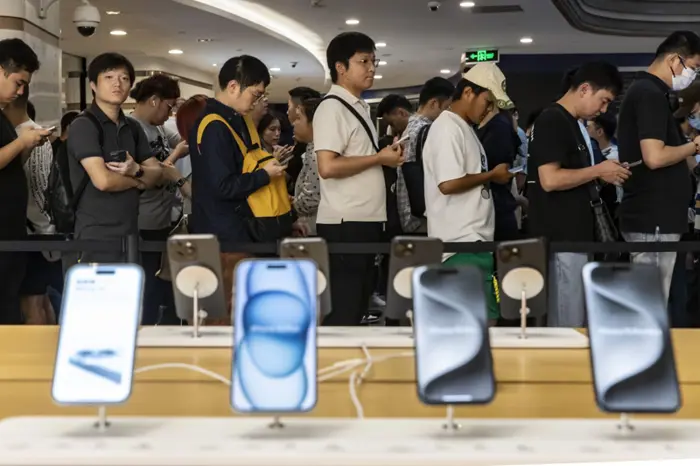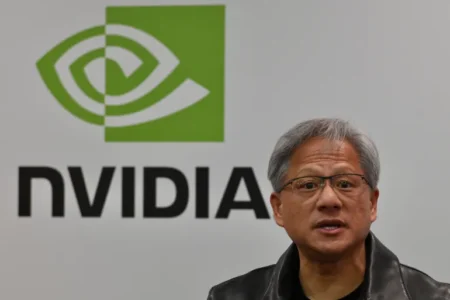China’s government has launched a huge trade-in subsidy program to encourage people to buy appliances, smartphones, and electric vehicles. The effort aims to revive slow consumer spending amid economic challenges and trade tensions with the United States.
Zhan Demi, a mother in Tianjin, eastern China, visited an electronics store to upgrade her iPhone. She needed more storage for photos and videos of her toddler and to download apps required by her children’s school. But the key reason she came was to use the government’s trade-in program, which offers discounts to boost purchases.
This year, China poured about US$42 billion into this trade-in subsidy program — twice as much as last year. The program covers many products, including washing machines, air conditioners, electric vehicles, and smartphones. Discounts typically range from 15% to 20%, especially for energy-efficient products.
The program’s success has been striking. Retail sales grew 6.4% in May, surpassing economists’ expectations. Demand for home appliances and smartphones led the surge. So popular is the scheme that some cities, like Chongqing, have paused the subsidies temporarily to avoid running out of funds too soon.
Zhan said she had already used the program to buy an energy-saving air conditioner and other home goods at big discounts. “If there is a good deal, we upgrade everything at once,” she said, adding that she saw the program as a chance to “shear wool from the sheep,” a Chinese phrase meaning to seize an opportunity.
However, despite this spending boost, many Chinese consumers remain cautious. Zhan said that when her favorite coffee shop raised prices, she chose to make coffee at home instead. “People compare prices more carefully because the economy is not strong,” she said. Unemployment, salary cuts, and job uncertainty are reasons many are careful about spending.
China’s consumer spending has long lagged behind that of developed countries. People save a lot and spend less, even when the economy grows fast. But growth is slowing now, jobs are harder to find, and the property market, a key source of wealth, remains weak. This makes boosting consumer spending critical to keeping the economy growing.
China faces limits on its usual methods of economic support. Local governments are heavily in debt after years of infrastructure projects like airports and bridges. Also, ongoing trade tensions with the U.S. and concerns about cheap Chinese exports restrict how much factories can increase exports.
Top government leaders are increasingly focused on encouraging consumer spending. Premier Li Qiang said China is “intensifying efforts” to expand domestic demand. He wants China to become a “megasized consumption powerhouse” alongside its manufacturing strength. President Xi Jinping vowed to “fully unleash” consumers to help counter trade war impacts.
The trade-in program began late last year, modeled after America’s “Cash for Clunkers” initiative. Initially, it covered eight types of home appliances and vehicles. This year it expanded to include smartphones, tablets, and smartwatches, funded partly by special Treasury bonds.
Still, economists warn that the program’s effect may be short-lived. Nomura, a Japanese investment bank, forecasts retail sales could fall in the second half of 2025 and early 2026. The government is testing new ways to support spending, including a plan to give families US$500 yearly for each child under three.
Another reason Chinese save more is their weak social safety net. Though most have medical and pension insurance, benefits are small and out-of-pocket costs are high. Many workers, especially gig economy employees, lack unemployment or workplace injury insurance.
Zhang Dylan, a car salesperson in Tianjin, saw a small sales boost from the trade-in scheme but said demand is much lower than two or three years ago. He and his wife bought a home in 2019 for about US$265,000, but its value has since dropped nearly 50%. Zhang believes many people hold back on spending because “it is too difficult to make money.”
At a Xiaomi phone store in Tianjin, Wang Mingke said sales rose from 20 to over 30 phones a month after the subsidies began, though early on they reached 50. Wang explained the program gave hesitant buyers a needed push but cautioned that many consumers now avoid spending on non-essential items due to income worries.
China’s trade-in subsidy program has clearly helped lift consumer spending in the short term. But as the government faces economic challenges and limits on traditional support, sustaining that momentum remains uncertain.







